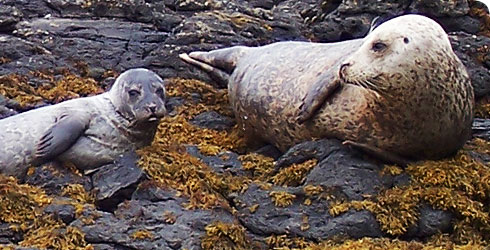Biology
Size
Adult males can grow up to 2.3m long and weigh 170–310 kg. Females can grow up to 2m and weigh 105–186 kg.
Within the Atlantic subspecies, seals from Canada are slightly larger than European grey seals (Jefferson et al, 2008).
Reproduction
Male grey seals mate with multiple females - they are polygynous - and they will occasionally fight for a mate. They deter other males from accessing the females by threatening them with open mouth displays, hisses and vocalisations which may end up in a fight that can last up to an hour (Perrin et al, 2009).
Breeding is on land between late September and early March, and differs through populations and locations. The populations around the British Isles are the earliest to breed and the Canadian populations and those in the Baltic Sea are the last (Jefferson et al, 2008).
The female seal gives birth to a single pup that is weaned within 15–20 days. In that time it increases 4-fold in weight. After weaning, it remains on land without eating for 2–4 weeks before venturing into the oceans (Jefferson et al, 2008).
The female’s milk is very rich and has a high fat content. The period of maternal care is very short so it is essential that the pup forms a good bond with the mother to obtain the maximum amount of milk before weaning, otherwise the chance of survival is low (Anderson et al, 1979).
There is evidence that the survival rate of grey seal pups is related to the density of the population on the haul out sites (Anderson et al, 1979). If a pup is born into a high-density population, the chance of it being separated from its mother is increased. It is therefore more likely to die from being crushed in a fight or from starvation (Cassini, 1999).
Female grey seals often go back to the same spot to breed year after year (Boness and James, 1979; Pomeroy et al, 1994). They sometimes return to breed at the site where they themselves were born (Pomeroy et al, 1994).
Nearly half the world’s grey seal population breeds around the UK, and 90 percent of these are in Scotland (Special Committee on Seals (SCOS), 2009).
Life expectancy
Males can live for over 20 years and females can live for over 30 years (SCOS, 2009).
